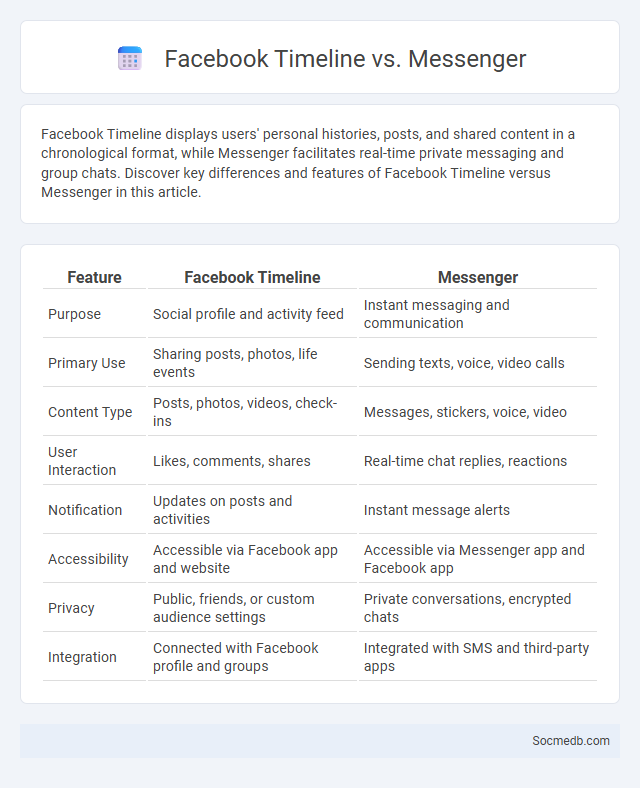
Photo illustration: Facebook Timeline vs Messenger
Facebook Timeline displays users' personal histories, posts, and shared content in a chronological format, while Messenger facilitates real-time private messaging and group chats. Discover key differences and features of Facebook Timeline versus Messenger in this article.
Table of Comparison
| Feature | Facebook Timeline | Messenger |
|---|---|---|
| Purpose | Social profile and activity feed | Instant messaging and communication |
| Primary Use | Sharing posts, photos, life events | Sending texts, voice, video calls |
| Content Type | Posts, photos, videos, check-ins | Messages, stickers, voice, video |
| User Interaction | Likes, comments, shares | Real-time chat replies, reactions |
| Notification | Updates on posts and activities | Instant message alerts |
| Accessibility | Accessible via Facebook app and website | Accessible via Messenger app and Facebook app |
| Privacy | Public, friends, or custom audience settings | Private conversations, encrypted chats |
| Integration | Connected with Facebook profile and groups | Integrated with SMS and third-party apps |
Overview of Facebook Timeline and Messenger
Facebook Timeline organizes user posts, photos, and life events in a chronological feed, allowing seamless navigation through personal histories and social interactions. Messenger integrates instant messaging capabilities, supporting text, voice, and video communication with friends and groups directly within the Facebook ecosystem. Together, Timeline and Messenger enhance connectivity by combining rich profile storytelling with real-time conversations.
Key Features of Facebook Timeline
Facebook Timeline showcases a user's life events, posts, photos, and shared content in chronological order, allowing easy navigation through years of activity. It includes sections for About information, Friends, Photos, and Posts, facilitating a comprehensive personal narrative. Interactive elements like tagging, reactions, and comments enhance social engagement directly within the timeline interface.
Core Functions of Messenger
Messenger's core functions include instant text messaging, voice and video calls, and seamless file sharing, ensuring you stay connected with friends and colleagues in real-time. The platform integrates chatbots and payment options, enabling efficient customer service and easy money transfers within conversations. Group chats and multimedia support further enhance communication, making Messenger a versatile tool for personal and professional interactions.
Timeline vs Messenger: Main Differences
Social media platforms separate communication into two main formats: Timeline and Messenger. Your Timeline serves as a public or semi-public space to share posts, photos, and updates visible to your network, enhancing your social presence and connections. In contrast, Messenger offers private, real-time conversations through direct messages, fostering one-on-one or group interactions that prioritize immediacy and confidentiality.
User Interaction and Engagement
User interaction and engagement on social media platforms drive meaningful connections and foster active community participation. Tailoring content to your audience's preferences enhances comment rates, shares, and likes, boosting visibility through algorithm-friendly behaviors. Effective engagement strategies leverage real-time feedback and personalized communication to sustain user interest and promote brand loyalty.
Privacy and Security Comparison
Social media platforms vary significantly in their approach to privacy and security, with some offering end-to-end encryption and robust user data protection policies, while others have faced criticism for data breaches and inadequate safeguards. Facebook and Instagram prioritize targeted advertising, leading to extensive data collection, whereas Signal and Telegram emphasize user anonymity and encrypted messaging. Users should evaluate privacy settings and security features like two-factor authentication to mitigate risks and protect personal information effectively.
Content Sharing Capabilities
Social media platforms enhance content sharing capabilities by enabling users to instantly distribute multimedia files, including images, videos, and articles, across global networks. Advanced sharing options allow for targeted audience segmentation, real-time interaction, and seamless integration with third-party applications, boosting engagement metrics. Algorithms prioritize personalized content delivery, increasing visibility and fostering dynamic community participation.
Usability and User Interface
Social media platforms prioritize intuitive usability and user interface (UI) design to enhance user engagement and retention. Streamlined navigation, responsive layouts, and accessible features allow you to effortlessly interact, share content, and connect with others. Continuous UI improvements based on user behavior analytics ensure a seamless experience tailored to your preferences.
Integrations with Other Facebook Services
Facebook integrates seamlessly with services such as Instagram, WhatsApp, and Messenger, enhancing user connectivity and cross-platform communication. These integrations enable unified messaging, synchronized notifications, and streamlined business tools, improving overall user experience. Marketers benefit from consolidated advertising management across Facebook's ecosystem, increasing campaign efficiency and audience reach.
Choosing Between Timeline and Messenger
Choosing between Timeline and Messenger depends on Your social media communication needs; Timeline allows public sharing and interaction through posts, comments, and media, enhancing your online presence. Messenger facilitates private, real-time conversations with individuals or groups, supporting multimedia sharing and instant notifications. Your choice should align with whether you prioritize broad engagement or direct, personal communication.
 socmedb.com
socmedb.com